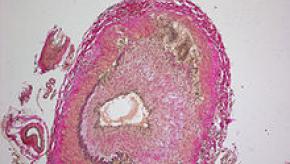Blogs
Pregnancy and Psoriatic Arthritis
Patient TS was a 30 year old woman who had been living with psoriatic arthritis for about 18 months. Her symptoms had started about 6 months after the birth of her first child with mild psoriasis in her scalp but increasing joint pain in her hands, wrists, elbows, knees, and ankles.
Best of 2021: Steroid Poker
It began as many cases do: an ill patient, in the ICU, with signs and symptoms across several body systems, yet no clear unifying diagnosis on admission. With things stabilizing, the internal medicine hospital team on which I was serving as hospitalist that week assumed care of the patient. As the case unfolded – pulmonary infiltrates that could be hemorrhagic, renal dysfunction with proteinuria – rheumatic diseases rose in the differential. When serologic studies and other data suggested GPA rather than glomerular basement membrane (GBM) disease or other possibilities such as infection, it seemed the right time to act. And that is when a game of what I call “steroid poker” began.ICYMI: Steroid Poker
It began as many cases do: an ill patient, in the ICU, with signs and symptoms across several body systems, yet no clear unifying diagnosis on admission. With things stabilizing, the internal medicine hospital team on which I was serving as hospitalist that week assumed care of the patient. As the case unfolded – pulmonary infiltrates that could be hemorrhagic, renal dysfunction with proteinuria – rheumatic diseases rose in the differential. When serologic studies and other data suggested GPA rather than glomerular basement membrane (GBM) disease or other possibilities such as infection, it seemed the right time to act. And that is when a game of what I call “steroid poker” began.Best of 2020: Steroid Poker
It began as many cases do: an ill patient, in the ICU, with signs and symptoms across several body systems, yet no clear unifying diagnosis on admission. With things stabilizing, the internal medicine hospital team on which I was serving as hospitalist that week assumed care of the patient. As the case unfolded – pulmonary infiltrates that could be hemorrhagic, renal dysfunction with proteinuria – rheumatic diseases rose in the differential. When serologic studies and other data suggested GPA rather than glomerular basement membrane (GBM) disease or other possibilities such as infection, it seemed the right time to act. And that is when a game of what I call “steroid poker” began.ACR20 Pearls Part 3: Pragmatic Applications for Managing Vasculitis
While the ACR prepares to publish its new guidelines for the diagnosis and management of vasculitis in the Spring of 2020, Dr. John Stone presented his own perspectives on the practical management of vasculitis during the 2019 ACR meeting in Atlanta. He acknowledged that what may be pearls one day, may be disproven with data in the future.Steroid Poker
It began as many cases do: an ill patient, in the ICU, with signs and symptoms across several body systems, yet no clear unifying diagnosis on admission. With things stabilizing, the internal medicine hospital team on which I was serving as hospitalist that week assumed care of the patient. As the case unfolded – pulmonary infiltrates that could be hemorrhagic, renal dysfunction with proteinuria – rheumatic diseases rose in the differential. When serologic studies and other data suggested GPA rather than glomerular basement membrane (GBM) disease or other possibilities such as infection, it seemed the right time to act. And that is when a game of what I call “steroid poker” began.The Story Teller
Angie is my last patient before lunch. I've known her since her RA diagnosis at age 17 years. And for the last 7 years, she’s matured into a fabulous young woman who has adeptly grown her professional life, her dating life and developed her independence, despite her severely active rheumatoid arthritis. But today I see she has a troubled and anxious look as I greet her.





